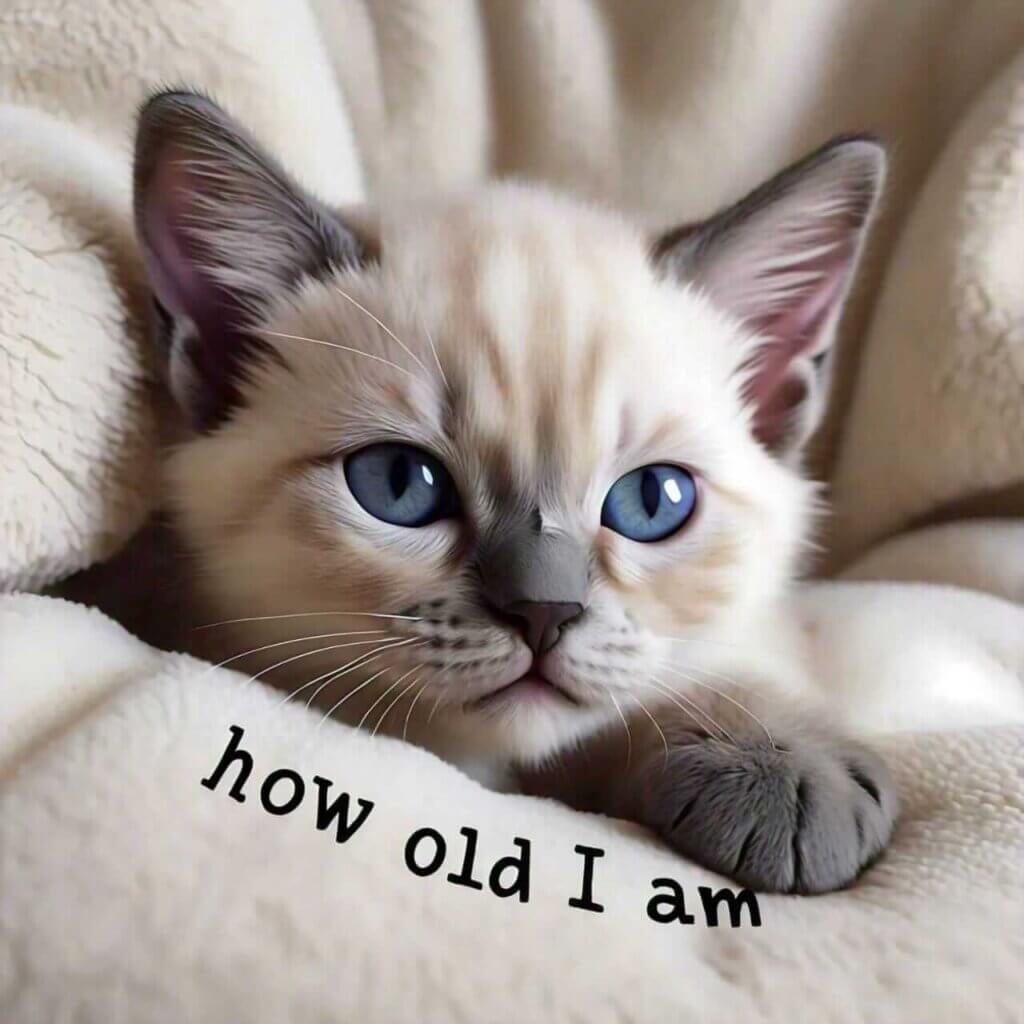Estimating the age of a kitten is crucial for providing proper care, from feeding schedules to vaccination timing. Whether you’re caring for a newborn or a newly adopted kitten, knowing their age helps you understand their development and needs.
Let’s explore the key indicators to determine a kitten’s age accurately, including physical characteristics, behavioral milestones, and expert advice.

Table of Contents
Understanding Physical Characteristics
Weight and Size
Kittens grow rapidly, and their weight can be a helpful age indicator. At birth, kittens typically weigh between 85-115 grams (about 3-4 ounces). They gain approximately 10-15 grams daily, doubling their birth weight by the first week.
By the fourth week, a kitten generally weighs around one pound. However, breed and nutrition can cause variations, so use this as a guideline rather than a strict rule.
Coat and Fur Texture
Newborn kittens have fine, soft fur. As they age, their fur thickens, and patterns or markings may become more apparent. By around the seventh week, you can see distinct color patterns, which can help in identifying certain breeds like Siamese, known for their “point” coloration that develops over time.
Week-by-Week Growing Progress
Here’s a set of tables outlining the week-by-week progress of a kitten’s development:

Week 1: Newborn
| Attribute | Description |
|---|---|
| Weight | 85-115 grams |
| Eyes | Closed |
| Ears | Folded and closed |
| Movement | Limited to crawling |
| Umbilical Cord | Attached, falls off within a week |
| Feeding | Nursing on mother or bottle-feeding formula |
| Body Condition | Fragile, delicate |
Week 2: Eyes Open
| Attribute | Description |
|---|---|
| Weight | 150-250 grams |
| Eyes | Start to open, usually blue |
| Ears | Begin to open, but still folded |
| Teeth | No visible teeth yet |
| Movement | Crawling with more strength |
| Feeding | Continued nursing or formula |
| Body Condition | Gaining weight steadily |
Week 3: Sensory Development
| Attribute | Description |
|---|---|
| Weight | 250-350 grams |
| Eyes | Fully open, still blue |
| Ears | Start to stand up, hearing develops |
| Teeth | Incisors begin to erupt |
| Movement | Starting to explore, wobbly walking |
| Feeding | Nursing/formula, introduction to solid food may start |
| Body Condition | Increased mobility and alertness |
Week 4: Increasing Activity
| Attribute | Description |
|---|---|
| Weight | 350-450 grams |
| Eyes | Blue, more focused vision |
| Ears | Fully open and responsive |
| Teeth | Canine teeth start to appear |
| Movement | Walking more confidently, beginning to play |
| Feeding | Nursing/formula, beginning to eat solids |
| Body Condition | Stronger, more coordinated |
Week 5: Playful Kitten
| Attribute | Description |
|---|---|
| Weight | 450-550 grams |
| Eyes | Blue, may start changing |
| Ears | Fully functional |
| Teeth | Premolars coming in |
| Movement | Climbing, jumping, playful interactions |
| Feeding | Mix of nursing/formula and solid food |
| Body Condition | Energetic, engaging in play |
Week 6: Independence
| Attribute | Description |
|---|---|
| Weight | 550-650 grams |
| Eyes | Color change may begin |
| Ears | Fully upright |
| Teeth | All baby teeth should be in |
| Movement | Very active, good coordination |
| Feeding | Eating more solids, reducing nursing |
| Body Condition | Independent, healthy development |
Week 7: Developing Personality
| Attribute | Description |
|---|---|
| Weight | 650-750 grams |
| Eyes | Permanent color starts to show |
| Ears | Alert and responsive |
| Teeth | All 26 baby teeth present |
| Movement | Engaging in complex play and social interactions |
| Feeding | Mostly solid food |
| Body Condition | Well-rounded, socializing actively |
Week 8: Ready for Adoption
| Attribute | Description |
|---|---|
| Weight | 750-850 grams |
| Eyes | Permanent color established |
| Ears | Fully developed hearing |
| Teeth | Baby teeth intact, adult teeth coming soon |
| Movement | Fully coordinated, independent, playful |
| Feeding | Fully weaned, eating solid food |
| Body Condition | Healthy, strong, ready for adoption |
These tables provide a clear and concise overview of a kitten’s developmental milestones each week, helping caregivers understand what to expect as the kitten grows.
Developmental Stages in Siamese Cat Kittens

Eye and Ear Development
Eye Color and Openness
Kittens are born with their eyes closed. They typically open them between 7-10 days old. Initially, all kittens have baby blue eyes, but this color can change over time.
The permanent eye color usually sets in around the sixth or seventh week. For instance, a “Seventh Week Darling” kitten may show a hint of their true eye color, which can be a vital clue in estimating age.
Ear Canals and Hearing
Newborn kittens have folded ears that gradually open and stand up as they grow. By two weeks, the ear canals open, and the kitten begins to respond to noises. The positioning of the ears and their responsiveness can help you gauge their age.
Dental Development and Milestones
Teeth Eruption and Development
Teeth are one of the most reliable indicators of a kitten’s age. The first to emerge are the incisors, around two to three weeks old, followed by canine teeth and premolars.
By six weeks, kittens usually have all their baby teeth, which are small and sharp. The transition to permanent teeth begins around three to four months. Observing the stage of tooth eruption can help you determine the kitten’s age.
Gums and Mouth Health
Checking the gums can also provide insights. Healthy, pink gums are typical in young kittens, while older kittens might show signs of dental wear or tartar buildup. A kitten’s mouth and teeth condition, especially if they still have baby teeth, can be a strong age indicator.
Behavioral Milestones
Movement and Coordination
Kittens start developing movement and coordination skills early. By the second week, they begin crawling, and by the fourth week, they are usually walking, albeit unsteadily. By the fifth or sixth week, kittens like a “Sixty Days Old Kitten” are more coordinated and capable of playing, climbing, and jumping.
Socialization with Littermates and Humans
Interaction with littermates starts around two weeks, progressing into more complex social behaviors by the fourth week. Kittens engage in play-fighting, grooming, and exploring.
Human interaction varies; younger kittens might be more reserved, while those around eight weeks old are typically more playful and curious.
Veterinary Advice and Kitten Age Charts
Scheduling a Vet Appointment
If you’re unsure about a kitten’s age, scheduling a veterinary appointment is crucial. Veterinarians can provide a more accurate age estimate based on a physical examination, including checking the kitten’s body condition, teeth, and developmental progress.
Kitten Age Charts and Resources
Using a kitten age chart can help you compare observed traits with standard developmental milestones. For example, charts can outline when to expect the transition from baby teeth to permanent teeth or changes in eye color and behavior.
Practical Tips and Care Guidelines

Feeding and Weaning
Knowing a kitten’s age is essential for proper feeding. Young kittens (up to four weeks) require kitten formula as they are still weaning. By six to eight weeks, they can start transitioning to solid food.
Umbilical Cord and Body Condition
Observing the umbilical cord can provide clues; it usually falls off within the first week of life. Additionally, a kitten’s body condition—whether they are lean, round, or somewhere in between—can indicate their age and overall health.
Conclusion
Determining a kitten’s age involves observing a combination of physical and behavioral characteristics. From the presence of baby teeth to changes in eye color and movement milestones, each aspect provides clues to their age.
Understanding these signs helps in providing the right care, from proper feeding to socialization and medical needs. If in doubt, consult a veterinarian to ensure your kitten grows into a healthy and happy adult cat.
FAQs
1. How can I estimate a kitten’s age based on its eyes?
Kittens open their eyes between 7-14 days old, with blue eyes visible initially.
2. What does ear development indicate about a kitten’s age?
Ears start to stand up around 3 weeks old, indicating early stages of hearing development.
3. How can teeth help determine a kitten’s age?
Kittens get their baby teeth around 2-4 weeks, and permanent teeth start appearing at 3-4 months.
4. How does a kitten’s weight help in estimating its age?
A healthy kitten gains about 1 pound per month, so that weight can help approximate its age.
5. What does the fur texture and color indicate about a kitten’s age?
Kittens often have softer, fluffier fur; adult coat starts developing around 6-8 weeks.
6. How can you use a kitten’s behavior to estimate its age?
Kittens begin walking and playing around 3-4 weeks old, with coordination improving as they age.
7. How can you tell a kitten’s age based on its feeding habits?
Kittens transition from milk to solid food around 4-5 weeks old.
8. What role do kitten eye color changes play in determining age?
Eye color may start changing from blue to its permanent color around 6-7 weeks old.
